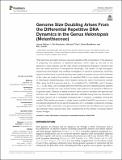Por favor, use este identificador para citar o enlazar a este item:
http://hdl.handle.net/10261/251457COMPARTIR / EXPORTAR:
 SHARE SHARE
 CORE
BASE CORE
BASE
|
|
| Visualizar otros formatos: MARC | Dublin Core | RDF | ORE | MODS | METS | DIDL | DATACITE | |

| Campo DC | Valor | Lengua/Idioma |
|---|---|---|
| dc.contributor.author | Pellicer, Jaume | - |
| dc.contributor.author | Fernández, Pol | - |
| dc.contributor.author | Fay, Michael F. | - |
| dc.contributor.author | Michálková, Ester | - |
| dc.contributor.author | Leitch, Ilia J. | - |
| dc.date.accessioned | 2021-10-04T07:50:12Z | - |
| dc.date.available | 2021-10-04T07:50:12Z | - |
| dc.date.issued | 2021-09-06 | - |
| dc.identifier | doi: 10.3389/fgene.2021.726211 | - |
| dc.identifier | e-issn: 1664-8021 | - |
| dc.identifier.citation | Front. Genet. 12, 726211 (2021) | - |
| dc.identifier.uri | http://hdl.handle.net/10261/251457 | - |
| dc.description.abstract | Plant genomes are highly diverse in size and repetitive DNA composition. In the absence of polyploidy, the dynamics of repetitive elements, which make up the bulk of the genome in many species, are the main drivers underpinning changes in genome size and the overall evolution of the genomic landscape. The advent of high-throughput sequencing technologies has enabled investigation of genome evolutionary dynamics beyond model plants to provide exciting new insights in species across the biodiversity of life. Here we analyze the evolution of repetitive DNA in two closely related species of Heloniopsis (Melanthiaceae), which despite having the same chromosome number differ nearly twofold in genome size [i.e., H. umbellata (1C = 4,680 Mb), and H. koreana (1C = 2,480 Mb)]. Low-coverage genome skimming and the RepeatExplorer2 pipeline were used to identify the main repeat families responsible for the significant differences in genome sizes. Patterns of repeat evolution were found to correlate with genome size with the main classes of transposable elements identified being twice as abundant in the larger genome of H. umbellata compared with H. koreana. In addition, among the satellite DNA families recovered, a single shared satellite (HeloSAT) was shown to have contributed significantly to the genome expansion of H. umbellata. Evolutionary changes in repetitive DNA composition and genome size indicate that the differences in genome size between these species have been underpinned by the activity of several distinct repeat lineages. | - |
| dc.description.sponsorship | The authors acknowledge financial support of the Agencia Estatal de Investigación—Ministerio de Ciencia e Innovación (Spanish Government: PID2019-108173GA-I00). JP benefited from a Ramón y Cajal contract (Ministerio de Ciencia e Innovación, Gobierno de España—Ref: RYC-2017-2274). PF and EM received Erasmus + grants from the European Union. | - |
| dc.description.tableofcontents | Abstract Introduction Materials and Methods Plant Material and DNA Sequencing Graph-Based Clustering in RepeatExplorer 2 Genome Dynamics and Relative Abundance of Particular Repetitive Elements Chromosome Preparations and Mapping of DNA Satellite HeloSAT by Fluorescence in situ Hybridisation (FISH) Results Repeat Content in H. koreana and H. umbellata Genome Size and Comparative Repeat Dynamics in Heloniopsis Identification and Characterisation of DNA Satellites Discussion Diversity and Dynamics of Repetitive Elements in Heloniopsis The Impact of Satellite DNA in Shaping Genome Evolution of Heloniopsis Conclusion Data Availability Statement Author Contributions Funding Conflict of Interest Publisher’s Note Acknowledgments Supplementary Material Footnotes References | - |
| dc.language | eng | - |
| dc.publisher | Frontiers Media | - |
| dc.relation | info:eu-repo/grantAgreement/AEI/Plan Estatal de Investigación Científica y Técnica y de Innovación 2017-2020/PID2019-108173GA-I00 | - |
| dc.relation | info:eu-repo/grantAgreement/AEI/Plan Estatal de Investigación Científica y Técnica y de Innovación 2017-2020/RYC-2017-2274 | - |
| dc.relation.isversionof | Publisher's version | - |
| dc.rights | openAccess | - |
| dc.subject | C-value | - |
| dc.subject | Chromosomes | - |
| dc.subject | DNA repeats | - |
| dc.subject | Satellite DNA | - |
| dc.subject | Transposable elements | - |
| dc.title | Genome Size Doubling Arises From the Differential Repetitive DNA Dynamics in the Genus Heloniopsis (Melanthiaceae) | - |
| dc.type | artículo | - |
| dc.identifier.doi | 10.3389/fgene.2021.726211 | - |
| dc.relation.publisherversion | http://dx.doi.org/10.3389/fgene.2021.726211 | - |
| dc.date.updated | 2021-10-04T07:50:12Z | - |
| dc.rights.license | http://creativecommons.org/licenses/by/4.0/ | - |
| dc.contributor.funder | Ministerio de Ciencia e Innovación (España) | - |
| dc.relation.csic | Sí | - |
| dc.identifier.funder | http://dx.doi.org/10.13039/501100004837 | es_ES |
| dc.type.coar | http://purl.org/coar/resource_type/c_6501 | es_ES |
| item.openairetype | artículo | - |
| item.grantfulltext | open | - |
| item.cerifentitytype | Publications | - |
| item.openairecristype | http://purl.org/coar/resource_type/c_18cf | - |
| item.fulltext | With Fulltext | - |
| Aparece en las colecciones: | (IBB) Artículos | |
Ficheros en este ítem:
| Fichero | Descripción | Tamaño | Formato | |
|---|---|---|---|---|
| fgene-12-726211.pdf | 1,54 MB | Adobe PDF |  Visualizar/Abrir |
CORE Recommender
SCOPUSTM
Citations
5
checked on 12-abr-2024
WEB OF SCIENCETM
Citations
10
checked on 21-feb-2024
Page view(s)
212
checked on 20-abr-2024
Download(s)
110
checked on 20-abr-2024
Google ScholarTM
Check
Altmetric
Altmetric
Este item está licenciado bajo una Licencia Creative Commons

